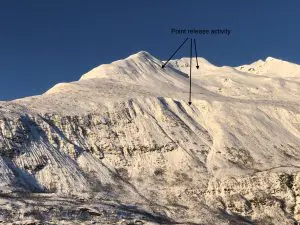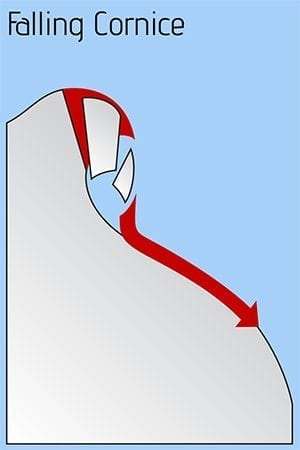Valdez
Above 3,000ftModerate
1,500 to 3,000ftModerate
Below 1,500ftModerate
Degrees of Avalanche Danger
Avalanche Problems
Problem 1
Falling cornices have been reported in multiple locations on 2/22 that failed within the last 48 hours. These have produced D3 (very large) avalanches in multiple locations including The Books. Cornices have been observed and reported as being larger than normal and poorly attached. Cracks on ridge tops showing cornices separating from ridge lines have been observed.
Cornices are an objective mountain hazard that should always be a concern. Although, recent activity strongly shows that we need to keep an extra cautious approach to avoiding overhead exposure to cornices. Avoid traveling below or on top of cornices. The avalanches that cornice fall has recently produced are unsurvivable events.

Likelihood:
- Almost Certain
- Very Likely
- Likely
- Possible
- Unlikely
Size:
- Historic
- Very Large
- Large
- Small
Trend
- Increasing
- Steady
- Decreasing
Problem 2
North winds ramped up on 2/20 with gusts to 50 mph along ridge tops. Wind slabs were found to be initially sensitive up to 1 foot in depth on SE-NW aspects. On 2/22 slabs were found to be gaining strength and stubborn to triggers. Signs of instability were observed and reported in isolated areas.
In many places these slabs were deposited on very low density snow, making slabs quite sensitive initially. This interface has been compressed since and sensitivity has decreased, although this problem may remain reactive in specific locations today up to 1 foot in depth. As slabs settle and gain strength the likelihood of triggering one of these decreases, but propagations could be wider due to the stiffness of the slab. Failure could occur once a person or machine is already on slope and initiate behind you. This problem will currently have a hollow drum like feel, shooting cracks will be a sign that avalanches remain possible.
Areas where the surface is unaffected by wind will provide better riding conditions and good stability.
Likelihood:
- Almost Certain
- Very Likely
- Likely
- Possible
- Unlikely
Size:
- Historic
- Very Large
- Large
- Small
Trend
- Increasing
- Steady
- Decreasing
Problem 3
Natural avalanche activity caused by cornice fall reported on 2/22 indicates that a persistent weak layer in the mid snowpack exists at upper elevations. The 1/14 buried surface hoar layer is likely the weak layer involved, although this has not been confirmed. This layer has been dormant for over three weeks, but recent activity shows that large triggers can still produce avalanches. Human triggered avalanches remain unlikely at this layer although large groups, cornice/ice fall, or large groups may be able to still produce avalanches at this layer.
Rain crusts that formed in late January have promoted faceting in the mid snowpack at low elevations (below 2500′). No natural or human triggered avalanches have been reported or observed that failed at this layer, although poor structure exists and stability tests have produced propagation at this interface.
As time goes on and this layer becomes deeper in the snowpack with additional snowfall, the likelihood of human triggers will be decreasing. It is still worth investigating this layer if traveling in steep/ consequential terrain at low elevations. Areas where the snowpack is thin will be the most susceptible to failures at this plane.
Likelihood:
- Almost Certain
- Very Likely
- Likely
- Possible
- Unlikely
Size:
- Historic
- Very Large
- Large
- Small
Trend
- Increasing
- Steady
- Decreasing
Problem 4
Weak snow created by early season cold temps, dry conditions and strong north winds have showed poor structure near the base of the snowpack. This weak snow has been dormant through the majority of the season with human triggered avalanches being unlikely at this layer. As the sun has come out the last few days several very large natural avalanches have occurred with cornice and ice falls being the triggers. Human triggers remain unlikely at this layer, although these events show that large triggers can affect this weak snow. Cornice fall will be the most likely trigger to affect this weak snow, although it is possible that a large group could have the same affect. Avoid overhead exposure to cornices.
In most location facets near the ground have been found to be rounding and unreactive in stability tests. In thin areas of the snowpack basal facets have been found to be more developed. If you find it is possible to push a ski pole to the ground in areas you travel, assume that a weak faceted snowpack exists in that location. These areas could act as a trigger point. An example of the difference in faceted snow that has been recently found can be seen below.

Depth hoar from Nicks Buttress ~4000′ North aspect 1/31. This was from an area where the snowpack 3 feet deep.

Rounding depth hoar on Cracked Ice / north aspect/ 3000′ on 2/11. This was from an area where the snowpack was 7 feet deep
Likelihood:
- Almost Certain
- Very Likely
- Likely
- Possible
- Unlikely
Size:
- Historic
- Very Large
- Large
- Small
Trend
- Increasing
- Steady
- Decreasing
Avalanche Activity
Below is a summary of observed Avalanche activity from the last 7 days. Avalanches that were noted earlier in the season can be viewed by clicking the link below.
If you trigger or observe an avalanche consider leaving a public observation.
2/22- Natural D 2.5 cornice fall avalanche was reported on a NW aspect/ ~6000 in the books. 

2/20- Numerous D1-D2 natural and human triggered avalanches were observed and reported up to 1 foot in depth on a variety of aspects. These occurred in areas where fresh wind slabs were present.
– D3 natural avalanche observed on Snoopys (Port of Valdez). NW aspect/ ~5000’/ ran ~3500 vertical feet with a track length of approximately 1 mile mapped on Google Earth. This was a hard slab avalanche the failed at weak layer in the mid snowpack. HS-N-R4 D3. No other avalanches of this size have been observed or reported in our forecast area.


2/15- The sun came out in full force after 6 inches of new snow and produced a significant amount of point release wet/loose activity near the coast on solar aspects. 2- D2’s were also noted in the mid and high elevation band of town mountain and Mile high.



Weather
Check out our updated weather tab! A collection of local weather stations are available for viewing with graphs and tabular data included.
NWS Watches and warnings
NONE NWS Point forecast for Thompson Pass
Date Thursday 02/23/23 Friday 02/24/23 Time (LT) 18 00 06 12 18 00 06 12 18 Cloud Cover OV OV OV OV OV OV OV OV OV Cloud Cover (%) 80 95 100 100 100 100 100 95 95 Temperature 17 13 14 22 24 21 19 22 21 Min/Max Temp 12 26 19 23 Wind Dir NE SW S S S SE W W N Wind (mph) 2 4 8 10 6 3 4 5 8 Wind Gust (mph) 21 23 Precip Prob (%) 10 50 90 90 90 80 80 70 70 Precip Type S S S S S S S S 12 Hour QPF 0.03 0.16 0.12 0.13 12 Hour Snow 0.2 2.3 1.6 1.9 Snow Level (kft) 0.0 0.0 0.0 0.0 0.1 0.0 0.0 0.1 0.0
Click on link below for Thompson Pass weather history graph:

| Date:
02/23 |
24 hr snow | HN24W* | High temp | Low temp | 72 hour SWE* | February snowfall | Seasonal snowfall | Snowpack Depth |
| Valdez | 0 | 0 | 29 | 11 | 0 | 69 | 214 | 63 |
| Thompson pass | 0 | 0 | N/O | N/O | 0 | 69 | 356 | 67 |
| 46 mile | 0 | 0 | 26 | 2 | 0 | ~16 | ~85** | 42 |
*HN24W- 24 hour Snow water equivalent in inches
*SWE– Snow water equivalent
**46 mile seasonal snowfall total begins December 1st.
Additional Information
Click on the link below for a running summary of the seasons weather history.
Announcements
The avalanche hazard is moderate at all elevations. Triggering a wind slab avalanche remains possible in isolated locations up to 1 foot in depth. Shooting cracks, collapsing and recent avalanche activity are all signs of unstable snow. Light snowfall today is not expected to be enough to affect stability. Multiple large-very large natural avalanches have been reported over the last 48 hours that have resulted from cornice and ice falls. Cornices should always be a hazard that we watch out for, although they appear to be particularly weak at this point. Avoid exposure to cornices as they have shown the ability to produce very large unsurvivable avalanches.
Posted by Gareth Brown 02/23 8:45 am.
For a description of current avalanche problems, weather information, season history and more click the (+ full forecast) button. Avalanche forecasts will be issued Wednesday-Sunday.
If you have pictures of recent natural or human triggered avalanches or notice signs of instability such as shooting cracks or collapsing, leave an observation to help improve forecast accuracy.



